I'm very new to swift and programing for IOS but I'm trying to create an app. I want to have a UITableView where i have some headers that if you click them they will open or close depending on if they are open or not. Is it possible to do this with headers or will I need to use a normal cell? This is how i have sett everything up so far. Thank you for any help?
Edits:
I am now able to open and close sections now but some gets removed. I have updated the code with the edits I have done so far.
her is how it looks when i click something.
var settings: [settingOptions] = [
settingOptions(isOpened: true, setting: "appearance", options: ["light mode", "dark mode"]),
settingOptions(isOpened: true, setting: "unit system", options: ["liters & milli liters", "ounzes"]),
settingOptions(isOpened: true, setting: "change goal", options: ["goal"]),
settingOptions(isOpened: true, setting: "how to use", options: []),
settingOptions(isOpened: true, setting: "remove data", options: [])]
@objc func expandOrCollapsSection(_ sender: UIGestureRecognizer){
print("Do something with section")
guard let section = sender.view?.tag else { return }
var indexPaths = [IndexPath]()
for row in settings[section].options.indices {
let indexPath = IndexPath(row: row, section: section)
indexPaths.append(indexPath)
}
let ioOpend = settings[section].isOpened
settings[section].isOpened = !ioOpend
if ioOpend {
tableView.deleteRows(at: indexPaths, with: .none)
} else {
tableView.insertRows(at: indexPaths, with: .none)
}
}
extension AboutVC: UITableViewDelegate, UITableViewDataSource{
func tableView(_ tableView: UITableView, cellForRowAt indexPath: IndexPath) -> UITableViewCell {
let cell = tableView.dequeueReusableCell(withIdentifier: "header") as! SettingOptionCell
cell.setting = settings[indexPath.section].options[indexPath.row]
return cell
}
func tableView(_ tableView: UITableView, numberOfRowsInSection section: Int) -> Int {
return settings[section].isOpened ? settings[section].options.count : 0
}
func numberOfSections(in tableView: UITableView) -> Int {
return settings.count
}
func tableView(_ tableView: UITableView, viewForHeaderInSection section: Int) -> UIView? {
let cell = tableView.dequeueReusableCell(withIdentifier: "settingCell") as! SettingsCell
cell.setting = settings[section]
cell.selectionStyle = .none
cell.addGestureRecognizer(UITapGestureRecognizer(target: self, action: #selector(expandOrCollapsSection)))
cell.tag = section
return cell
}
func tableView(_ tableView: UITableView, heightForHeaderInSection section: Int) -> CGFloat {
return 60
}
func tableView(_ tableView: UITableView, didSelectRowAt indexPath: IndexPath) {
}
}
}
class SettingOptionCell: UITableViewCell {
var setting: String? {
didSet {
guard let string = setting else {return}
option.text = string.capitalized
}
}
let option: UILabel = {
let lable = UILabel()
lable.text = "test"
lable.textColor = UIColor.white
lable.font = UIFont(name: "AmericanTypewriter", size: 17)
lable.translatesAutoresizingMaskIntoConstraints = false
return lable
}()
override init(style: UITableViewCell.CellStyle, reuseIdentifier: String?) {
super.init(style: style, reuseIdentifier: reuseIdentifier)
self.addSubview(option)
option.leftAnchor.constraint(equalTo: self.leftAnchor, constant: 20).isActive = true
option.centerYAnchor.constraint(equalTo: self.centerYAnchor).isActive = true
self.backgroundColor = .none
}
required init?(coder: NSCoder) {
fatalError("init(coder:) has not been implemented")
}
}
class SettingsCell: UITableViewCell {
var setting: settingOptions? {
didSet {
guard let setting = setting else {return}
self.title.text = setting.setting.uppercased()
}
}
var title: UILabel = {
let lable = UILabel()
lable.text = "Test"
lable.font = UIFont(name: "AmericanTypewriter", size: 20)
lable.textColor = .white
lable.translatesAutoresizingMaskIntoConstraints = false
return lable
}()
var container: UIView = {
let view = UIView()
view.clipsToBounds = true
view.backgroundColor = .none
view.translatesAutoresizingMaskIntoConstraints = false
return view
}()
override init(style: UITableViewCell.CellStyle, reuseIdentifier: String?) {
super.init(style: style, reuseIdentifier: reuseIdentifier)
self.backgroundColor = .none
self.isUserInteractionEnabled = true
contentView.addSubview(container)
container.addSubview(title)
title.leftAnchor.constraint(equalTo: container.leftAnchor).isActive = true
title.centerYAnchor.constraint(equalTo: container.topAnchor,constant: 30).isActive = true
container.topAnchor.constraint(equalTo:contentView.topAnchor).isActive = true
container.leftAnchor.constraint(equalTo:contentView.leftAnchor).isActive = true
container.rightAnchor.constraint(equalTo:contentView.rightAnchor).isActive = true
container.bottomAnchor.constraint(equalTo:contentView.bottomAnchor).isActive = true
}
required init?(coder: NSCoder) {
fatalError("init(coder:) has not been implemented")
}
}

